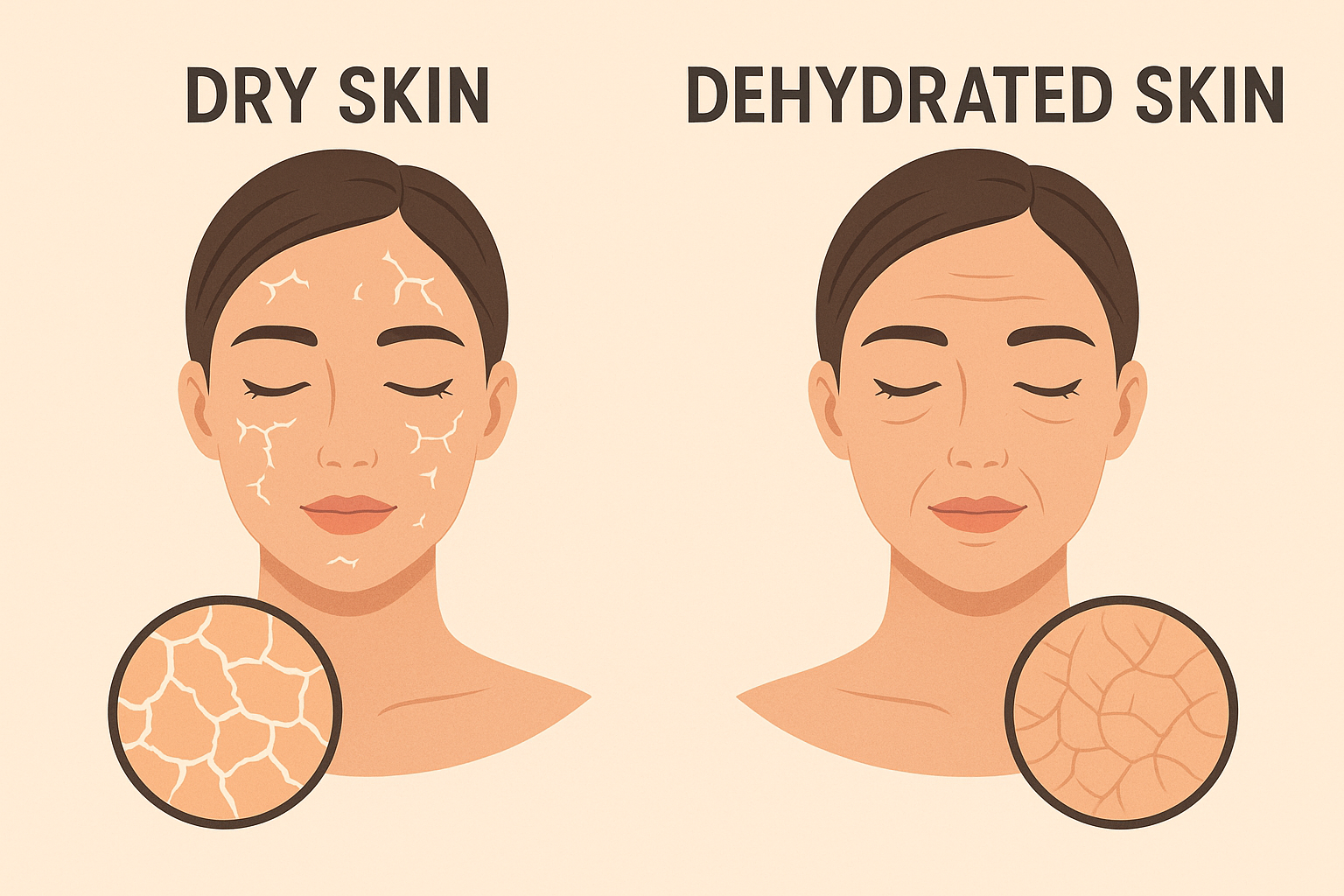Have you ever looked in the mirror and noticed your skin feels tight yet looks shiny? Or perhaps it feels rough, flaky, and uncomfortable no matter how much moisturizer you apply. If so, you might be dealing with something many people confuse: the difference between dry skin and dehydrated skin.
These two conditions are often misunderstood and approaching one as if it were the other can lead to more frustration, wasted money, and ineffective product choices. The good news is that once you understand the difference, you can give your skin more appropriate care.
This comprehensive guide will teach you the real difference between dry and dehydrated skin, how to correctly identify what your skin is experiencing, and the best methods to care for each situation appropriately . Whether your skin is oily, dry, sensitive, or combination, hydration and nourishment are the foundation of a skin’s natural balance.
Dry Skin vs. Dehydrated Skin: What’s the Difference?
Understanding the difference starts with a simple distinction: dry skin is a skin type, while dehydrated skin is a skin condition. They are fundamentally different, though they can occur simultaneously.
What Is Dry Skin?
- Dry skin means a lack of oil (sebum).
- This is a permanent skin type based on how much oil your skin naturally produces. People with dry skin genetically produce less sebum compared to other skin types.
What Is Dehydrated Skin?
- Dehydrated skin means a lack of water (moisture).
- This is a temporary skin condition. Any skin type: oily, dry, combination, or normal, can become dehydrated when the skin loses moisture or when water evaporates faster than it is replenished.
Why the Distinction Matters
Addressing dehydrated skin with oils won’t resolve the lack of moisture, and focusing only on water-based products for dry skin won’t provide the needed nourishment. When people confuse these two, they often end up overloading with the wrong products, leading to breakouts, more dryness, or skin sensitivity.
How to Know If You Have Dry Skin
Dry skin has certain characteristics that remain consistent regardless of seasons or lifestyle factors because it’s tied to your skin’s genetics.
Signs of Dry Skin:
- Skin feels rough, flaky, or scaly.
- Tightness, especially after cleansing.
- Fine lines may appear more visible when the skin feels less supple.
- Dull, ashy, or lackluster appearance.
- Skin rarely (if ever) gets oily or shiny.
- Makeup clings to dry patches and can look uneven.
- May feel sensitive or irritated, especially in cold weather.
Common Causes of Dry Skin:
- Genetics: Some people naturally produce less sebum.
- As skin matures, it may produce less oil, which can make dryness more noticeable.
- Weather: Cold temperatures and low humidity strip skin of natural oils.
- Harsh soaps: Cleansers with sulfates or strong surfactants worsen dryness.
- Overwashing: Strips the skin’s natural oils, further affecting skin’s comfort.
How to Know If You Have Dehydrated Skin
Dehydrated skin behaves differently because it’s about water loss, not oil. Even oily skin can be severely dehydrated.
Signs of Dehydrated Skin:
- Skin feels tight, uncomfortable, or itchy.
- Appears shiny or oily but feels dry underneath.
- Increased oil production as the skin tries to compensate.
- Fine lines appear suddenly or are more visible, especially when smiling or making expressions.
- Redness, dullness, or uneven skin tone.
- Occasional breakouts, congestion, or irritation.
- Makeup looks cakey or settles into fine lines despite moisturizing.
Common Causes of Dehydrated Skin:
- Lack of water intake: Insufficient hydration from within.
- Over-exfoliation: Excessive use of acids, scrubs, or retinoids.
- Harsh cleansers: Stripping cleansers that affect skin’s comfort.
- Skipping moisturizer: Especially after cleansing.
- Environmental stress: Sun, wind, dry air, pollution, or air-conditioned environments.
- Hot showers: Prolonged exposure to hot water can evaporate moisture from the skin.
Can You Have Both Dry and Dehydrated Skin?
Absolutely, and it’s very common. You can have skin that produces too little oil (dry) and simultaneously suffers from water loss (dehydrated).
For example, someone with genetically dry skin might also be exposed to cold weather, drink little water, and use harsh products, causing dehydration. Similarly, someone with oily skin might notice that, despite the shine, their skin feels tight and uncomfortable, a sign of dehydration without dryness.
Caring for both concerns usually involves combining hydration and nourishment for better skin comfort.
Final Thoughts
Confusing dry skin with dehydrated skin is one of the most common skincare mistakes, but now that you understand the difference, you’re equipped to give your skin more suitable care. Whether your skin lacks oil, water, or both, the solution is within reach.
Focus on hydration when your skin feels tight and dull, and nourishment when your skin feels rough, flaky, or constantly dry. Sometimes, the key is layering both: hydrating serums followed by rich moisturizers and nourishing ingredients.
Maintaining healthy-looking skin isn’t about using many products, but about choosing suitable products for your skin’s needs. Once you meet your skin’s needs consistently, you’ll notice maintained comfort, better texture, and a comfortable appearance year-round.
⚠️ Disclaimer: The information provided in this article is for educational purposes only and is not intended as medical advice or diagnosis. Skincare needs vary from person to person. If you experience persistent redness, irritation, or other skin changes, please consult a dermatologist or qualified professional for personalized guidance.
